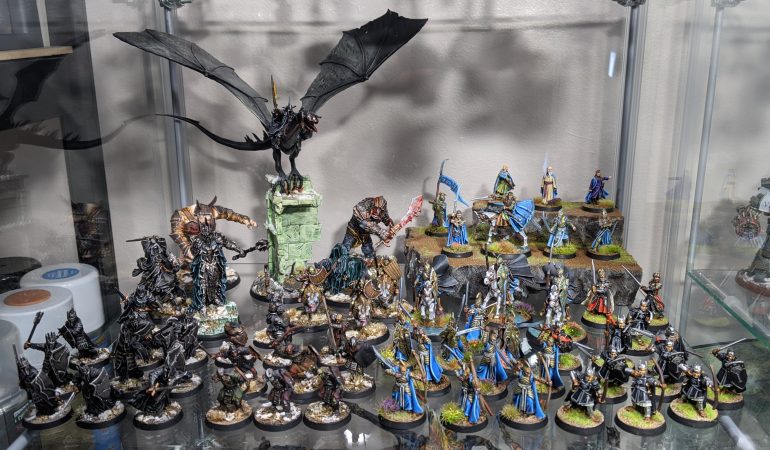
“Brutal is the wind that blows that attempts to hold us back. Since there was a time it has tried to keep us from our fight against its fury. Mary have fallen, but far more remained. On this day, we fight to end that which returns to destroy this world and all within it. We began this journey together and none but us can see it to its end. There can be no wind to blow against us now for we have found our strength. In alliance with Men, Elves and Dwarves, we end this now and end it forever.” – Lord Elrond to the Last Alliance (Battle of Dagorlad)
Hello internet, and welcome back to Plastic Crack! With the three part behemoth that is my Barrels out of Bond diorama finally behind me, it’s time to get stuck into something a little more gaming related.
After a couple of months on a display piece, I had every intention of finally cutting out a chunk of my backlog and painting my Azog’s Legion army. Back in 2019, I acquired the vast majority of this army in a big bundle of built but unpainted miniatures from a Facebook Buy & Sell page and they’ve been sitting on my shelf patiently awaiting their turn for.. oh God. Has it been 9 months already? Between this army, my Barrels out of Bond miniatures that formed the core of the diorama and my Blackstone Fortress miniatures, Summer 2019 really has a lot to answer for.
Anyway, that was the plan. Instead, something else happened. I.. Well, I bought more miniatures, I guess. Whoops.
See, ever since I started working on miniatures for the Fellowship of the Ring narrative campaign, there’s been this voice in the back of my head screaming at me that The Last Alliance is a crucial part of that movie. That little voice agonises to me that if you’re going to do the film in full, then you need to replay that scene too. It doesn’t help matters that I already have a considerable number of painted High Elves, Mordor Orcs and even Sauron himself. Had I wanted to play, say, the Last Alliance scenario out of the Armies of the Lord of the Rings book, I was only really short 26 Mordor Orcs, 1 Mordor Troll, 36 Númenóreans, Elendil and Isildur. That might not sound like a trivial amount of miniatures, but put it in perspective of the entire list of requirements:
Elrond, Gil-Galad36 High Elves (12 Swords, 12 Spears, 12 Bows)1 High Elf Banner- Elendil, Isildur
- 36 Númenóreans (12 Swords, 12 Spears, 12 Bows)
The Dark Lord Sauron- 4 Orc Captains (one down, 3 to go)
- 2 Mordor Trolls (with one already finished)
- 72 Mordor Orcs (46 already in the bag)
Having already completed the contingent of High Elves, almost 2/3rds of the Mordor Orcs, The Dark Lord Sauron and a Mordor Troll (albeit a Captain model) for unrelated projects, I was in a rare position where such a large scale scenario would be.. pretty achievable. Even still, it can be hard to find the time to paint 36 Númenóreans, let alone another 24 Orcs – neither of which I felt I especially needed or wanted for gaming purposes beyond this one big narrative scenario game.
And so the little voice in the back of my head continued to scream at me to DO THE LAST ALLIANCE while the rest of me continued chipping away at my backlog. What I did do was set up a few choice eBay alerts, awaiting the day the right deal would show up and would force my hand.
And finally, that day had arrived. A listing popped up on eBay for a Númenórean army that pretty much exactly fulfilled my needs – 14 Swords, 13 Spearmen and 12 Bows, plus Elendil and Isildur. Painted, and not half badly either!

After careful inspection for any glaring mould lines1, I satisfied myself that these were well within the realms of “good enough for home gaming” and placed my maximum bid. A couple of days passed and I had managed to score the listing – and for a little less than the RRP of these minis no less. Shortly after, I receive my minis in the post – and I really am most impressed. While the somewhat more ornate Elendil and Isildur minis could use a little more depth and contrast, the overall quality of paint job on the Númenórean soldiers themselves was really rather nice. The black tunics and cloaks were given subtle highlights of grey over the raised areas – perhaps a little more subtle than I might’ve done myself, but the paint job was immaculately clean for it. The greys and silvers in the trim were neatly painted, with solid coverage even a little subtle highlighting on the corners. The whites and creams had shadows in all the right places. The Spearmen even had a wee freehanded Star of Elendil painted on the little banners on their spears. Considering that I managed to pick these minis up for less than RRP, this lot was an absolute steal given the overall quality of paint job on them.
There were a couple of chips here and there that needed repairing, but honestly the only real work these guys really needed to get them table ready was repainting the base rim. I love a bit of goblin green base rim nostalgia as much as anybody, but these guys needed to fit in with my Rivendell Elves, after all – and honestly, I think they look a hundred times better for it.

So, here we are at almost 1000 words into this blog post and all I’ve painted so far is 38 base rims. Let’s get onto the cool things I did myself, shall we?
Well, I have to admit – writing this much about these Númenór miniatures made me feel a little guilty about leaving Elendil and Isildur as they were – next to my Elrond and Gil-Galad, they just looked a little bit flat. Time for a makeover.
Frustratingly, I didn’t think to take a ‘before’ photo, so the best I’ve got is my low resolution group photo and the out of focus group shot from the eBay listing, but you sort of get the idea. The main updates I made to these miniatures were the red robes, which have had the highlighting dialled up a good few notches to something a little closer to my own painting style. This was done by layering Bloody Red, highlighting with Rosy Flesh and then glazing a few layers of a mix of the pairs to blend it a little. Additionally, I added some quick and dirty highlights to Elendil’s black cloak using Black and White, repainted the ivory lining with Elfic Flesh and Seraphim Sepia, repainted the faces, applied some extra highlighting to the hair and beards, plus I pin washed and edge highlighted all of the silver and gold metallics.
I’m really glad I took the time to spruce these guys up. They’re big heroes, and really deserved a little extra effort to make them pop – there’s a very good chance they’ll be showing up in game photographs facing off against Sauron, after all. Plus, it’s just nice to have a piece of this Númenor army to really call my own. All in all, a satisfying result for an hour or two of hobby.
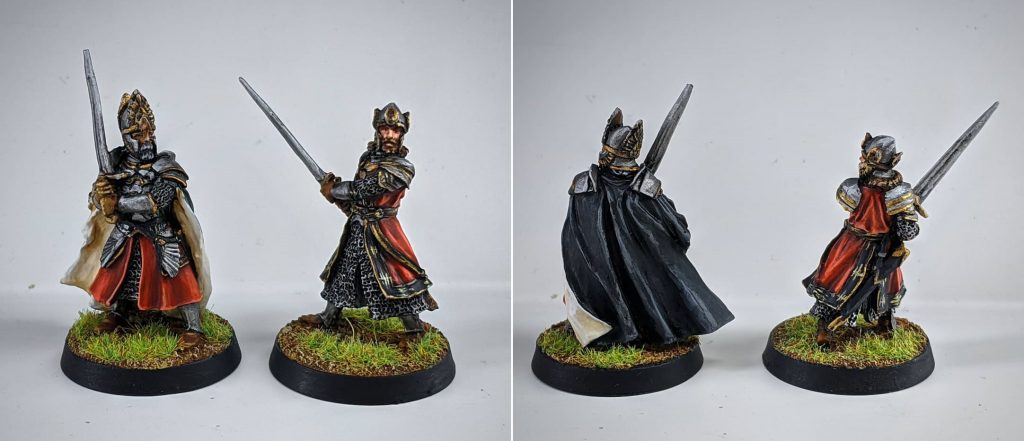
With my remaining painting options limited to 3 Orc Captains, 26 Mordor Orcs or a single Mordor Troll, I took the only sane option available to me and borrowed2 a plastic Mordor Troll from a Pellanor Fields box that I’m currently holding onto for a mate. Lockdown is savage, man.
What a fun kit to build and paint that was. As far as the build is concerned, there’s not too much to speak of – like most of the Lord of the Rings plastics, the kit has a good few years under it’s belt, and so is not the cleanest fitting kit I’ve ever put together. It reminded me a good bit of the plastic Rat Ogre that I put together for my Mordheim warband, in more ways than one. Some of the pieces don’t quite fit together perfectly, and there’s some creative gap filling to do in places – but boy, does this kit come with some cool options. You build it as an Mordor Troll or an Isenguard Troll, the latter of which has an Uruk-hai style helmet and a big gnarly shield bit that will absolutely be getting used in a conversion piece somewhere down the road. The Mordor Troll, however, comes with 2 styles of head – one of which has optional helmet – plus a couple arm and weapon options to boot. It’s just a neat little kit with an impressive amount of mileage – and I think the miniature that it produces really holds up.
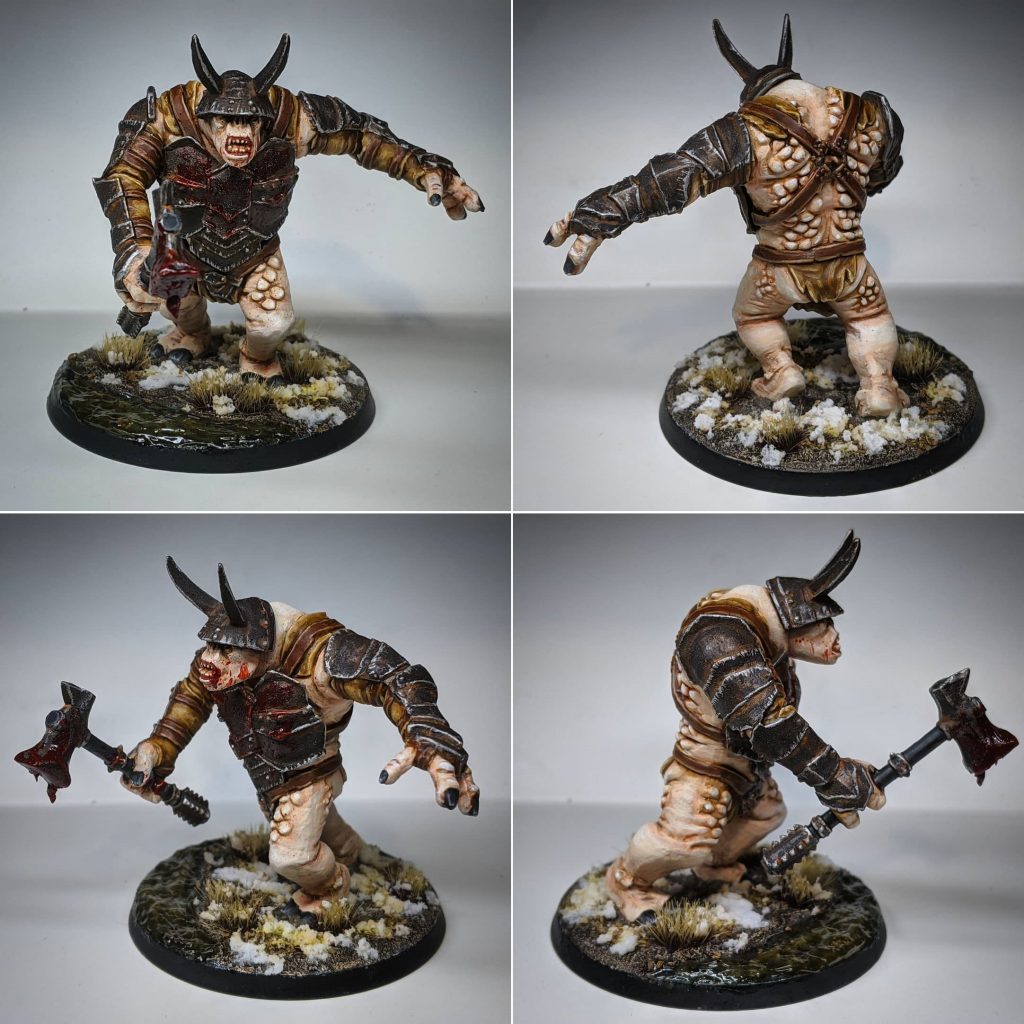
I have to say, I’m really rather pleased with how this mini turned out. In a weird way, I think that this came out as a sort of exemplar representation of my approach to painting miniatures. There’s a lot of Michael Hanns mini painting tropes on there – some old, some new. You’ve got my typical two tone leathers, based on Vallejo Leather Brown and Dark Fleshtone. You’ve got my favourite approach to rusty armour – Plate Mail Metal, coated in Typhus Corrosion, pin washed with Ryza Rust and edged with Shining Silver. I’ll give you three guesses as to the paints I used for the fleshtone, or what techniques I used to shade and highlight them. Even the base is done in my vanilla Lord of the Rings Evil style with dark dirt, grimy water texture, yellowed snow and Wasteland Tuft. None of this had occurred to me until I now, but if somebody asked me to show them just one miniature that typifies my approach to painting, it would probably be this Mordor Troll.
I did attempt a couple of newish things on this miniature though – the first and I think most successful of which is the feathered edge highlights on the armour. I guess you could almost compare it to stippling, but I’m essentially making loads of tiny little tapered lines perpendicular to the edge. This gives the armour a scratchy, jagged look – as if the edges of the armour plates were cut roughly with sharp edges. I really like it, and it’s something I’m definitely going to use more of on my Azog’s Legion project down the line.
Another neat little trick I decided to try playing with was mixing Blood for the Blood God into a little water texture to create a kind of dripping gore coming off the end of the hammer. It worked okay, but in hindsight I might not have used enough water texture, as the effect ended up looking pretty dinky after it cured. I did discover that when that same mixture is applied sparingly to the armour, you get a Blood effect that has a little more body and texture to it, and feels more like full-on gore than just a little blood spray. I will definitely experiment with that again in the future.
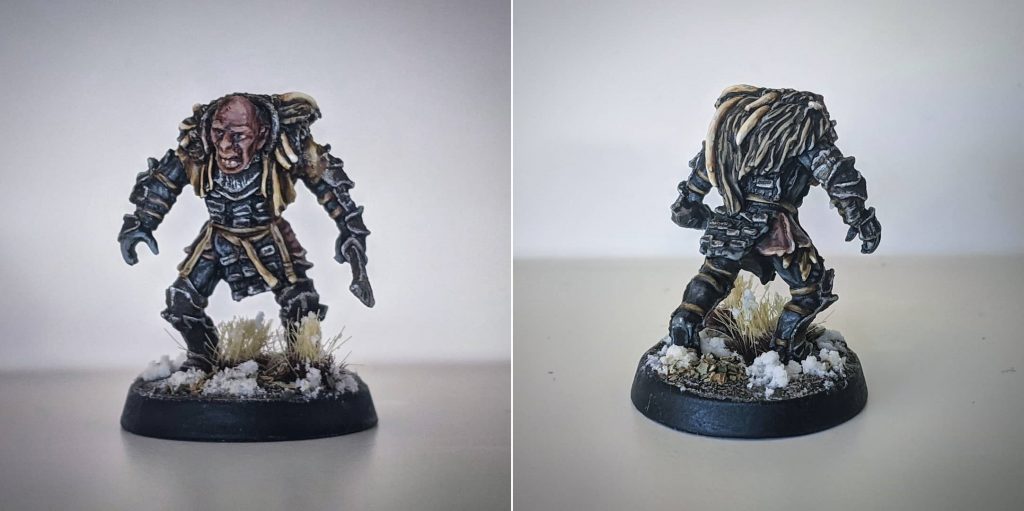
After finishing up my Mordor Troll, I started to think about Orcs. In addition to a further 26 Mordor Orcs, I also needed 3 more Orc Captains. This.. wearied me. As much as I enjoyed painting my first Orc Captain miniature, I hate repeating myself. This might seem at odds with being a tabletop wargamer, and I appreciate that a certain amount of repetition is required to create that uniformed army feel on the tabletop, but I find it really hard to get excited about collecting large numbers of any individual model or unit for the sake of having a lot of them. There’s just too many miniatures in my backlog, too many miniatures in my wish list and too damn many awesome miniatures as yet unreleased to waste time painting the same thing over and over.
I tell you this because the longer that I contemplated owning four3 Orc Captains and 72 plastic Mordor Orcs, the more I realised how utterly insane this would be. When, in the name of God, would I ever find myself fielding four Orc Captains again or over 420+ points of basic Mordor Orcs for that matter?
Thankfully, I stumbled upon some inspiration sitting pretty in my pile of shame – Grishnakh. This particular miniature is one that I’ve owned for coming up on two decades, having received him in an issue of the fabled Battle Games in Middle-earth partwork series. Grishnakh was recently rescued from the claustrophobic confines of an old Citadel figure case to lead the Orc contingent of my Isenguard Scout army4, and he’s been sitting in my pile of shame ever since.
I had a good look over the miniature itself and nothing about the model absolutely screams Third Age – there’s nothing to say this wouldn’t be right at home in Sauron’s forces as a Captain. Everyone’s got their own lines in the sand on this proxying miniatures, but I’ve always considered named characters to be acceptable proxies for generic characters (but never the other way around). This way, I get to paint a wholely new miniature, advance my Isenguard Scout forces a little bit and give myself another Orc Captain all in one fell swoop. Efficiency at work, folks.
He was also very fun to paint and I managed to take a pretty fun photograph of him sitting in my Barrels out of Bond diorama. Remember that scene?
I was feeling pretty good about my creative solution to avoiding repetition with the Orc Captains, but what about the Orcs themselves? Surely there was something more interesting I could do instead. Something that was there at the Last Alliance, that fills the need for more bodies on the tabletop, that would maybe not be quite so draining to paint 26 of in a relatively short space of time.
That’s when it hit me. Throughout the War of the Last Alliance, Orcs were not the only evils faced by the free peoples of Middle-earth. Also fighting Sauron’s corner were a great number of evil men, represented in Games Workshop’s Middle-earth miniatures range by Black Númenóreans. On paper, these seemed like the perfect substitution for Mordor Orcs. If you look at them from a battlefield role perspective, they’re still a Strength 3 infantry miniature on a 25mm base, albeit with a higher Fight, Defence and Courage than your standard Orc, as well as causing Fear. These improvements over the basic Orc statline do come at a cost – a single Black Númenórean is around 50% more expensive than a Mordor Orc similarly equipped. Still, given that I will already have 46 Orcs on the table, the difference between a further 24 Orcs or 16 Evil Men doesn’t feel like too much of a game changer – especially given their higher Defence value and the scenario’s reinforcement mechanic for the Evil player.
It really didn’t hurt that I could paint 16 Black Númenóreans a lot quicker than I could paint another 24 Orcs, either.
The only downside is that the miniature support for these Evil Men is somewhat… limited. The only two kits that Games Workshop produce are a set of monopose finecast infantry with a grand total of three unique sculpts and a surprisingly modern set of plastic cavalry which are oddly enough a little cheaper per miniature5. Now, personally, I don’t have too much of an issue with the Finecast Black Númenórean Warriors in a vacuum – aesthetically, I think they capture the vibe of the Mouth of Sauron pretty well, and he’s probably the closest visual reference we have to these guys from the Peter Jackson films. The problem, for me, is when you start comparing them to the rest of the range – they’re chunkier and more heroically proportioned than much of the range (a common issue with many Middle-earth miniatures that were not made to coincide directly with the film). This wouldn’t really be the end of the world, but for two issues:
- Everything else I have so far for the Last Alliance is reasonably small and delicate. Even allowing for the idea that Black Númenóreans could potentially be larger than their loyalist counterparts (the Mouth didn’t exactly look ‘human’ anymore), the discrepancy in proportions between those miniatures and the regular (teeny tiny) Númenóreans is just a little too jarring for my tastes.
- They look really different from Morgul Knights. I mean, there’s some obvious commonality there, but the tone and proportions just look completely different. I don’t have any immediate plans to add any Morgul Knights to my collection, but if I did, the huge aesthetic difference would really bother me. Given how much I hate retreading ground, I wanted to future proof myself against such a thing.
My path was clear: I would have to convert my own.
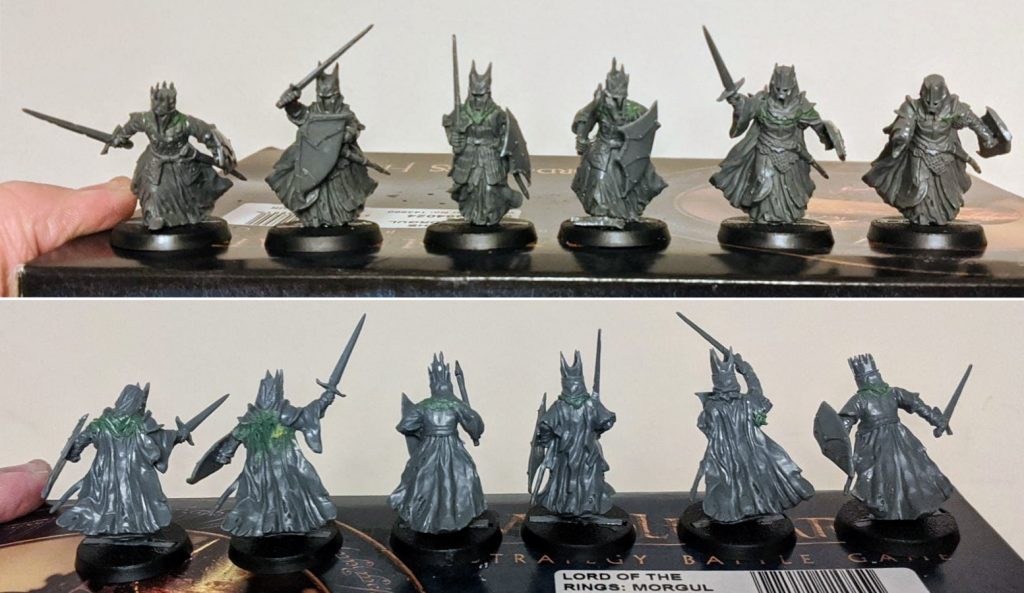
So, I’ll admit right off the bat – the idea for this conversion is not entirely my own; I’ve seen the idea for converting Black Númenóreans out of Army of the Dead models floating around the internet for a long time. When I was researching how to pull this off, I looked at a lot of conversions online, though I was never fully satisfied with the outcome. There were a good few that pretty much amounted to painting Warriors of the Dead in black, which works in a pinch if you’re looking for a budget alternative to Finecast, but I had a very specific goal in mind – to make these guys look like Morgul Knight dismounts. So, where better to start than Morgul Knights themselves, I guess?
Okay, so elephant in the room – yes, I did have to use up a full Morgul Knight miniature in the process of building each of these infantry miniatures, and yes this did ultimately drive up the price per miniature. However, when you consider that the Morgul Knights themselves work out at roughly 20% cheaper than their Finecast Infantry countparts, suddenly this doesn’t sound quite so mad. Thanks to the Battle of Pellanor Fields starter set driving down the cost of Warriors of the Dead on eBay, the final price of this unit barely cost me more than £10 more than were I to buy the stock Finecast models – and doing it this way also netted me two Black Númenórean Marshall minis as well. Not bad.
The Morgul Knight kit gives you an awful lot to work with – all of the riders are provided completely separate from their horses, with detached lance arms and shields. For my purposes, this meant that removing their head and shoulders was a relatively straightforward job with a hobby saw, while their shields – a big part of what gives the Morgul Knight their aesthetic – could be freely swapped out with the base miniatures to complete the look.
The Morgul Knight kit also contains parts to make a mounted Black Númenórean Marshall – what this amounts to is an impressive looking sword arm, and a slightly more pronounced hooded helmet. Unfortunately, this is not really as “optional” as the kit would have you believe. First of all, the only distinguishing features on the Marshall in this kit from a basic Knight is that aforementioned head, and the use of a sword instead of a lance. This is all well and good, except that the kit does not provide any alternative heads should you not wish to use this mini as a Hero. This means that should you decide you already have enough Marshalls, your only way to build this mini as a ‘Warrior’ is to use the optional lance instead of the raised sword. This would almost be alright, except that you can in fact arm a Marshall with a lance if you wish – at which point there’s zero difference between a Knight and a Marshall with lance. It’s not the end of the world, and given that the Morgul Knights kit is a full £10 cheaper than the equivalent Rivendell Knights kit (presumably due to licensing reasons), you’re still working out cheaper throwing every 6th Knight in the bin. It still feels a bit like a wasted opportunity though; I can’t help but think that they if could’ve made room on the sprue for a single headswap for that one torso, the whole kit would feel more feature complete.
But let’s go out on a high note here – because the legs are completely unattached from the armoured horses (a rarity in Games Workshop plastics these days), this does mean that I now have 18 LOTR-scale armoured horses complete with bases for my bitz box left over from this conversion. I can’t say I know what I’m going to use these for yet, but as far as bonus bitz go, it’s a fairly substantial haul. You wouldn’t get that buying 16 Finecast Black Númenóreans, that’s for sure.
Anyway, back to the conversions.
The basic premise here is relatively simple: cut away the head and shoulders from a Morgul Knight and a Warrior of the Dead, attach the shoulders to the Warrior’s body with plastic glue, then extend the cowl that drapes beneath the helmet with green stuff – and in doing so, cover up the seam. For a final touch, use a Morgul Knight shield instead of one from the Warriors of the Dead frame and you’re good to go, albeit with a few caveats.
First of all, there’s those big Marshall heads. I wanted my Hero models to have a little more distinguishing them than a fat head – not least because one of those heads would be getting used on a basic Warrior. Because of this, I decided to save the two most impressive Warrior of the Dead torsos for the Marshalls. A box of 20 Warriors of the Dead comes with 2 identical sprues, and on each sprue of there are two individual sword and shield armed Warriors that have a cool, leather-wrapped armour and long, billowing cloak. As I was only making 18 models total, this meant I could reserve those two torsos for the Marshalls, allowing the Heroes a distinct aesthetic of their own, without being duplicate miniatures. The other major distinguishing factor was the sword – I wanted to use the sword arms from the Morgul Knight’s kit, which featured a more pristine looking sword and a cool, commanding pose. That sword arm also came along with a big armoured pauldron on the shoulder. To that end, I carefully removed the head and shoulders a little lower on the Morgul Knight’s torso than the others, preserving the left pauldron. Together, this created a meaner, bulkier frame for the Hero models.
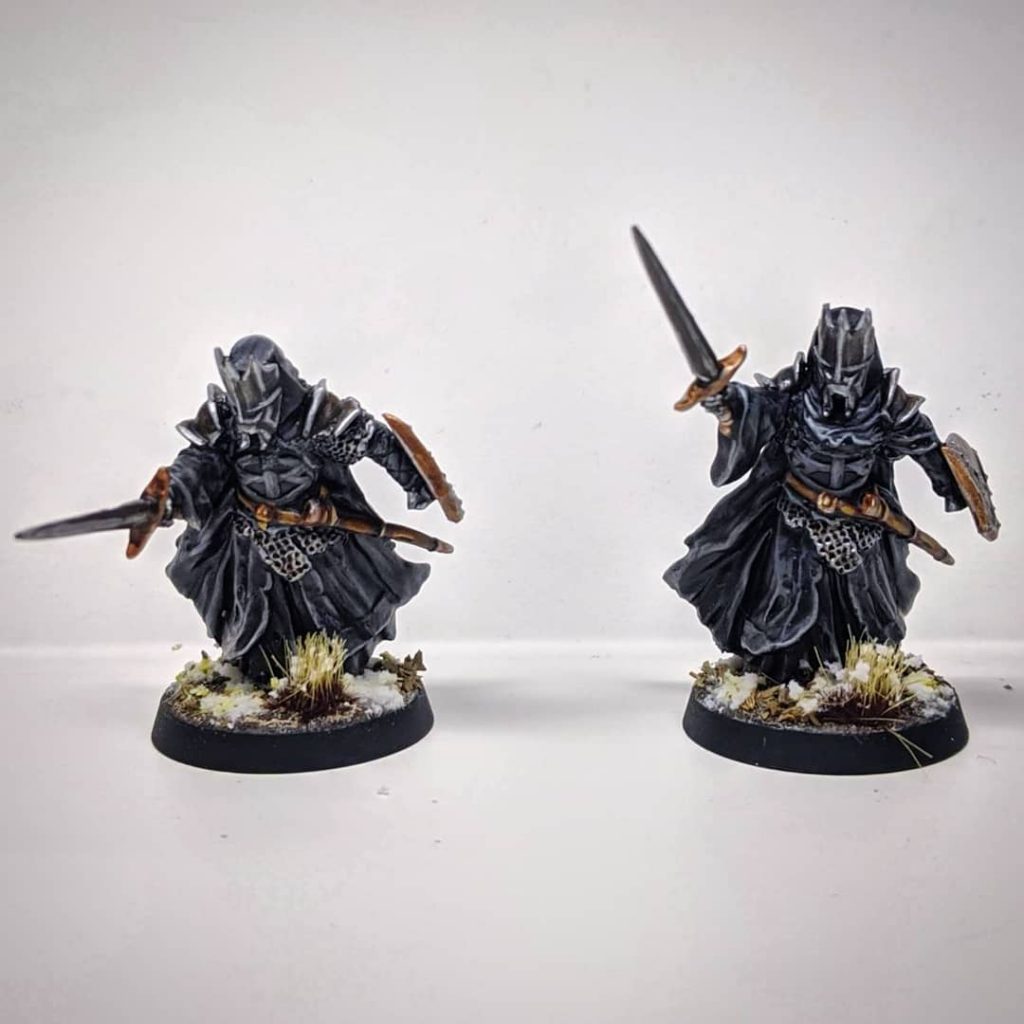
The other caveat was that Warriors of the Dead are not all armed with a sword and shield – some of these are carrying axes, maces spears.
I deliberated a little on the axes and maces, but on the whole, I think it’s fine. Speaking purely from a rule perspective, Black Númenórean’s come armed with swords, but you can always change a Warrior’s basic single-handed weapon’s type for 1 point (page 86 of the big rulebook). As far as fluff and aesthetic goes, well, they’ve been away from Númenor for some time. It’s probably fine that some of their ranks have chosen (or scavenged) a new weapon of choice. Spears on the other hand are a different kettle of fish – it’s a different class of weapon altogether, and not an upgrade available to these models. This is an absolute non-issue for the narrative purpose I have in mind for these guys, but I don’t want to get caught out if I ever want to take these to a tournament or something either. They would have to be converted.
The results are.. mixed, overall. Some of the spearmen have made for cool, dynamic poses and the inclusion of those sculpts massively increases model variation. Others come off as a little bit awkward. I think that if I was to do these conversions again, or build more of them, it might worth buying a second box of Warriors of the Dead just to avoid having to include some of the more awkward poses. While I’m at it, if I had an unlimited supply of Warriors of the Dead, I might also leave out the ones that don’t come with a cloak. Thanks to the cowls on the Morgul Knight helmets, it’s easy enough to get away with from a conversion perspective, but I think they lose some of their presence without a cloak, and some of my conversions give me the impression of a long neck.
The last thing I have to say about the conversions themselves is that you might notice that the final product has a bit of a hunched look about them. That’s really down to the Warriors of the Dead they’re based on – there’s a spectral, floaty sense of movement to the those sculpts that doesn’t entirely translate when painted to look more.. corporeal. Thankfully, it’s easy to dial back some of this energy by wedging a small flat stone or a bit of sprue underneath their front feat, tilting the miniature back and reducing the angle a little. They’ve still got a bit of a top forward look to them, but I think it comes off as more hunched and twisted than spectral and spooky.
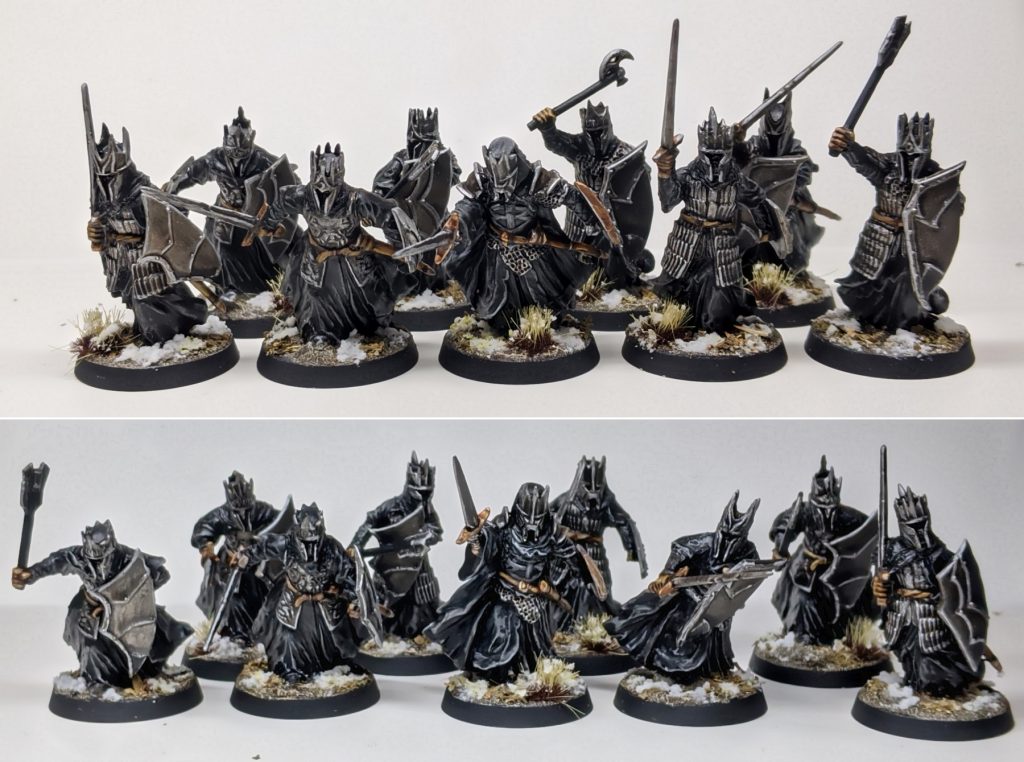
As far as paint jobs go, these guys were a doddle. I really don’t have much to say about them at all – I primed them with a can of Chaos Black and aggressively drybrushed them Mechanicus Standard Grey, Heavy Bluegrey and Wolf Grey. Following this, I base coated the metallic areas in Vallejo Metal Color Silver and washed the whole model with Nuln Oil. After this had dried, I picked out the finest black edges with Wolf Grey again, dulled down the recesses and flattest areas with thin glazes of Nuln Oil and picked out the edges on the shields and metallic armour with Shining Silver. For a hint of colour, I base coated the leather belts, sheaths and gloves in Dark Fleshtone, layered with Leather Brown, highlighted with Elfic Flesh and washed down with Seraphim Sepia. The sword hilts and metallic ends on the sheaths were painted Brassy Brass, washed with Reikland Fleshshade then layered and highlighted with Brassy Brass and Shining Silver respectively. A quick texture, drybrush, wash, tuft and snow effect on the base and that’s all she wrote.
The paint job took me a couple evenings to do all 18 miniatures total, with the Heroes receiving just a little bit more time individually than the basic Warriors. And, well, they kind of look it. It’s a quick and dirty paint job, but one that will look great on the battlefield alongside 48 Orcs, 8 Warg Riders and Sauron – and that’s pretty much all I needed them for, and I can always go back and add to it should I ever find myself at a loose end.
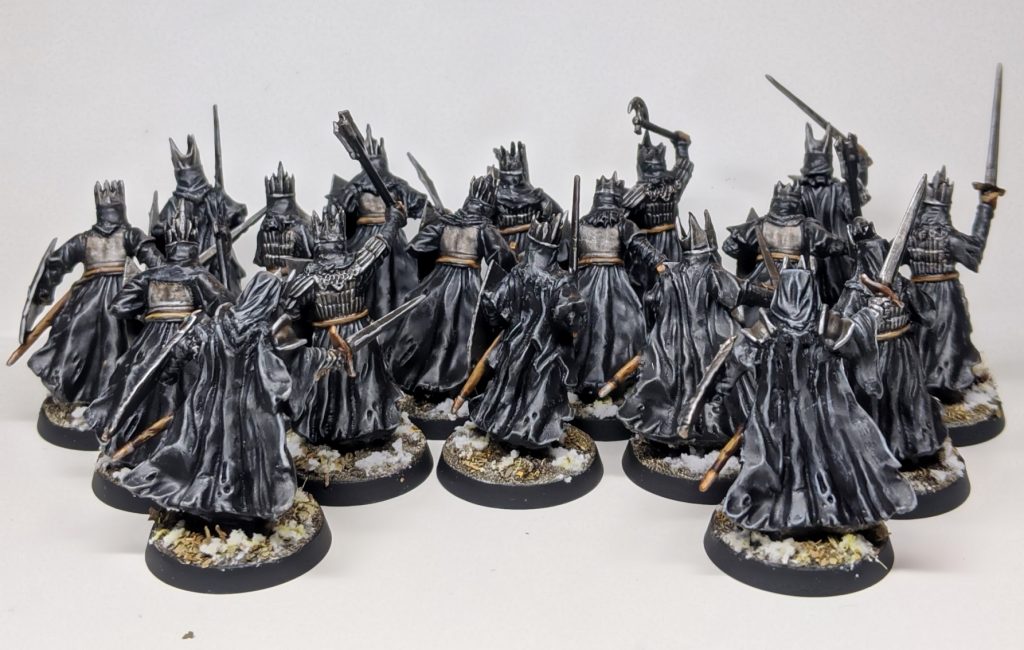
But for now, I’m just happy to call this project finished. The Last Alliance is one of those iconic, pivotal battles that’s on every Middle-earth wargamers bucket list, and it’s going to make for an immensely satisfying prequel to my Fellowship of the Ring Narrative Campaign. I can’t wait to finally get all of these miniatures together on the tabletop once this lockdown finishes.
In the meantime, here’s a quick shot of my now feature complete Last Alliance shelf in my Middle-earth display cabinet.

So, what’s coming up next? Well, after almost a year in stasis, I’ve finally found the inspiration to paint up my Azog’s Legion army – and it’s really coming along. I’m pretty proud of how these miniatures are shaping up, so stay posted next month for my thoughts on that army.
Until then, as always thanks for reading, and happy wargaming.
1 In my experience, 4/5 eBay miniatures that have already been painted still have seams and mould lines present. If you’re looking to save yourself some time (rather than necessarily scoring a bargain), I’d avoid these – the process of scraping off seams and repainting over the bare plastic is tedious and time consuming – you’re practically as well just painting the minis from scratch.
2 Craig, if you’re reading this, IOU one plastic Mordor Troll.
3 Four Orc Captains, Jeremy? Four? That’s insane.
4 Yep, that’s still in the pipeline. I’ve got Mauhur and Vrasku now to join Uglúk and Grishnakh too. I really wish I could get the new Snaga mini from ForgeWorld without the new Grishnakh (which is also nice, but you know, repetition).
5 At the time of writing this, Black Númenóreans came in a blister of 4 Finecast miniatures for £16 vs the plastic kit of 6 Morgul Knights for £20, making the cavalry miniatures around 20% less expensive than the infantry. Go figure.
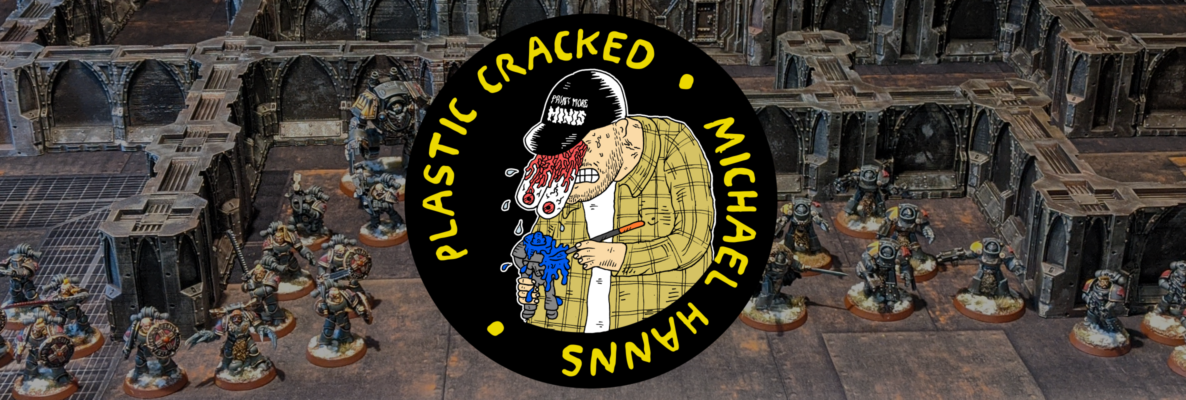
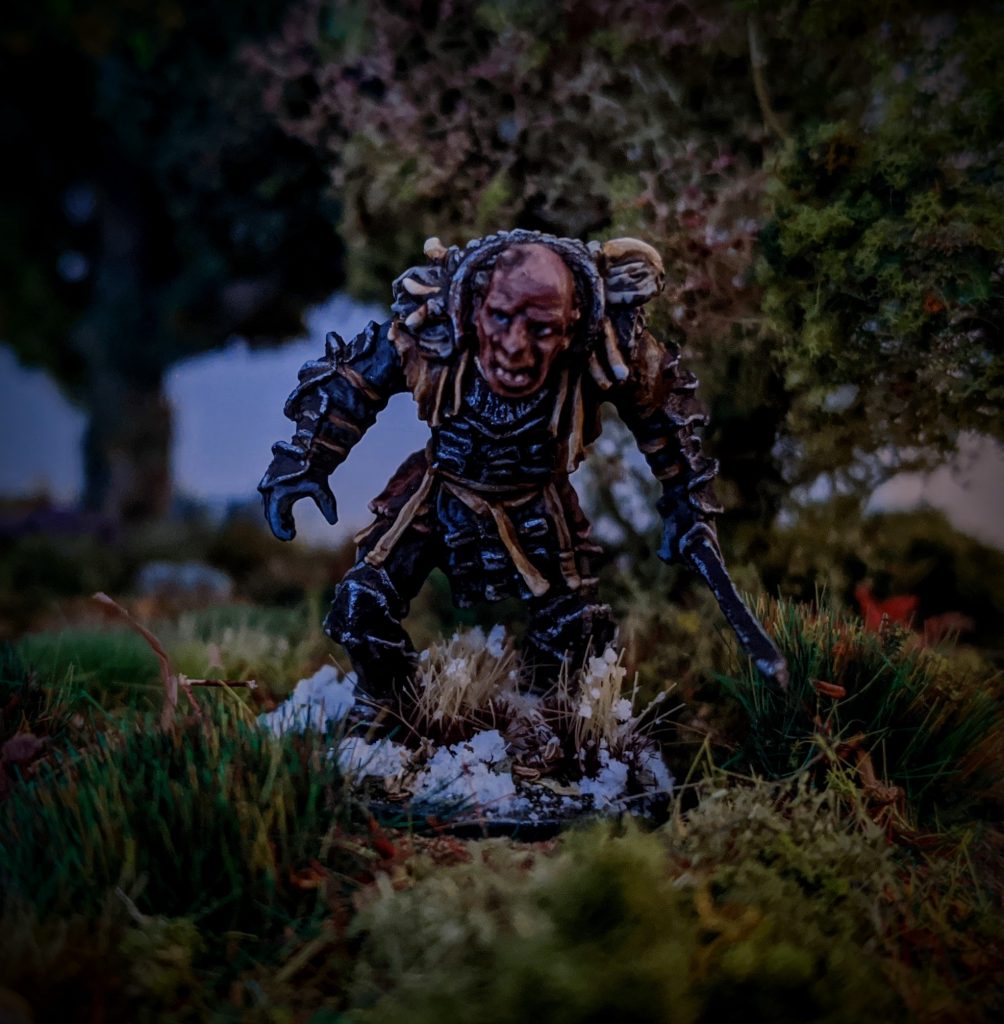
Your black numenoreans look incredible. Have you considered moulding one with a banner and or a warhorn?
I have a potentially large conversion project on my mind at the moment, also involving black numenoreans and morgul knights. The knights are my favourite model. I will definitely be purchasing the warriors of the dead and extra morgul boxes, I love your work.
I would be very interested to hear your thoughts on my project. It’s based around the idea that Mordor sends a squadron of heavily armed morgul knights and black numenoreans east, to assist the Harad, their client state due to incursions or rebellions. The army idea, is based around the notion that a unit of morguls and black numenoreans have spent years on patrol campaigns in the deserts alongside their haradrim allies, picking up on some of the culture and garb of their native friends. Such as turbans on some of their heads, perhaps an eastern silk throw over a marshal’s horse etc. I was envisaging assimilation of cultures between the two allied contingents.
This would be my first conversion project and I am an amateur when it comes to understanding and finding the best bits and bobs to assist with such a thing. So any thoughts you have I’d really appreciate.
Matt
Hi Matt – apologies for how long it’s taken to get back to you here, I’ve been a little swamped with projects as of late!
First of all, thank you for the very kind words – they are most appreciated. I’d love to go back and add a banner and a warhorn at some point, although I haven’t put much thought into how I’d achieve it yet (part of me reckons the new Heralds minis for AOTD might make a good starting place for the banner though).
As for your army idea – I think that sounds super cool! I love seeing army projects where narrative concepts affect the direction the modelling and painting. I definitely reckon you could achieve such a look by combining bits and pieces from the Harad range alongside bits from the Warriors of the Dead and Morgul Knights, plus the odd bit of sculpting – with a little bit of practice, it’s not too difficult to sculpt simple turbans using a little bit of green stuff and some silicone clay sculpting tools to get a flat, smooth finish. It might to cool to see what you could appropriate from the Haradrim Raiders kit as well – something as simple as adding the fan things that riders wear on their backs to the Morgul Knights kit would give them a bit of a Harad-influenced look. Perhaps you could even see how possible it would be to use some horses from the Haradrim Raiders as the steeds for your Morgul Knights – perhaps some of the Morgul Knights steeds perished in the conditions of the Harad climate and had to be replaced with local steeds from their allies.
Either way, it’s a cool idea and I’d love to see how it pans out!
Thanks again for commenting,
Michael